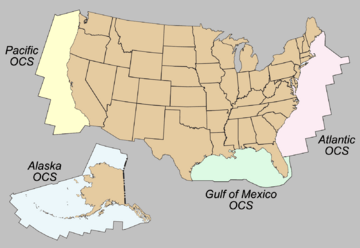Outer Continental Shelf facts for kids
The Outer Continental Shelf (OCS) is a special area of underwater land that belongs to the United States. Think of it as the part of the country's underwater land that is outside the control of individual states. It's like a big, important underwater backyard for the whole country!
Contents
What is the Outer Continental Shelf?
The Outer Continental Shelf, or OCS, is all the land under the ocean, including the soil and seabed, that is part of the United States but lies beyond the areas controlled by the states. States usually control the waters very close to their coastlines. The OCS starts where state control ends and stretches far out into the ocean.
This area is divided into four main parts for managing its resources:
- Gulf of Mexico OCS Region
- Atlantic OCS Region
- Pacific OCS Region
- Alaska OCS Region
Where Does State Control End?
Each U.S. state has control over the waters and land very close to its coast. This is called "state jurisdiction."
- For states like Texas and Florida's Gulf coast, their control goes about 9 nautical miles (about 16.7 kilometers) out from the shore.
- For Louisiana, it's also about 3 nautical miles (5.5 kilometers) from the shore, based on older rules.
- For all other states, their control usually extends about 3 nautical miles (about 5.5 kilometers) from the coast.
Where Does Federal Control Begin?
The OCS is where the U.S. federal government has control. This area can stretch much farther out into the ocean. It can go as far as 200 nautical miles (about 370 kilometers) from the coast. In some cases, if the continental shelf extends even further, the OCS can go up to 350 nautical miles (about 648 kilometers) from the coast.
The exact boundary of the OCS isn't always a simple line on a map. It's often decided by special laws and agreements, rather than just how the land looks underwater.
Laws and Agencies for the OCS
The Outer Continental Shelf is very important because it holds many natural resources, like oil, natural gas, and places for wind energy. Because of this, special laws and government groups manage it.
One of the most important laws is the Outer Continental Shelf Lands Act (OCSLA), created in 1953. This law officially defined the OCS as the submerged lands beyond state waters that belong to the U.S. It also made the Secretary of the Interior responsible for managing how these resources are explored and developed.
Different government groups in Washington D.C. help make and update these laws:
- The Senate Committee on Commerce, Science & Transportation handles OCS laws in the United States Senate.
- In the House of Representatives, the Committee on Natural Resources Subcommittee on Energy and Mineral Resources takes care of OCS rules.
Over the years, the way the OCS is managed has changed. Here's how some agencies have helped:
- In 1982, the Minerals Management Service (MMS) was created. It was in charge of leasing out parts of the OCS for mineral exploration and making sure offshore operations were done safely.
- In 2010, the MMS changed its name to the Bureau of Ocean Energy Management, Regulation and Enforcement (BOEMRE).
- Then, in 2011, BOEMRE was split into two new groups:
- The Bureau of Safety and Environmental Enforcement (BSEE) makes sure that oil drilling and offshore wind energy projects in federal waters are safe and don't harm the environment.
- The Bureau of Ocean Energy Management (BOEM) handles the leasing of OCS areas for energy development.
These agencies work hard to make sure that the valuable resources of the Outer Continental Shelf are used responsibly and safely for everyone.


